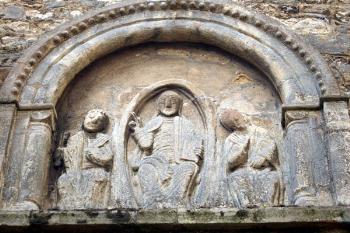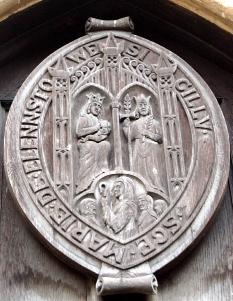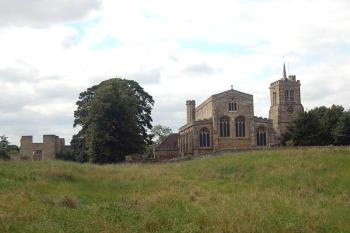Elstow Abbey

Tympanum over south door Sep 2007
This page gives a brief history of the institution of Elstow Abbey; separate pages are dedicated to the buildings and to the later history of the church. Elstow Abbey was founded by Countess Judith. She was a niece of William the Conqueror, the daughter of his half-sister Adelaide. She was married to Waltheof, Earl of Huntingdon, a powerful Anglo-Saxon nobleman from whom William wished support to legitimise his reign. Waltheof rebelled against his new master twice, in 1069 and 1074, being executed for the latter offence.
Judith inherited many of Waltheof's lands locally, including a considerable amount in Bedfordshire. She let land at Kempston, Maulden and Wilshamstead as well as at Elstow itself to help endow an abbey for Benedictine nuns at Elstow. It is not known exactly when she did this but was probably after Waltheof's death in 1076.
How Judith's life played out after the Domesday Survey is unknown, but has not stopped speculation. De Comitissa alleged WIlliam the Conqueror (her uncle) attempted to force a union between her and Simon de Senlis - her refusal was supposed to have resulted in her expulsion from England. However, this was not the case, not least because of the age gap and morevover, because Simon married Judith's eldest daughter, Maud. The important thing was that Judith's abbey survived.

Copy of the Abbey seal over west door September 2007
King Henry I (1100-1135) had granted the first charter to the Abbey on its completion in the late early 12th century. The first recorded Abbess was Cecily and other endowments were made to finance the foundation, Henry I giving lands in Hertfordshire (Hitchin and Weston) and King David I of Scotland (1124-1153), who married to one of Judith's daughters, gave land in Tottenham [Middlesex]. Henry I's charter was confirmed by Henry II (1153-1189) in the second half of the 12th century.
The Abbey was originally dedicated to Saint Mary and the Holy Trinity. In 1272 a man named Ivota built a chapel in the grounds devoted to Saint Helena, mother of the first Christian Roman Emperor, Constantine the Great (306-337). Four years before this King Henry III (1216-1272) had stayed at Elstow Abbey when attending a tournament in Bedford. In the middle of the 13th century Elstow Abbey had acquired a reputation for immorality. This was highlighted by the fall from grace, in 1270, of one of its nuns, Agatha Giffard, sister of the Archbishop of York and of the Bishop of Worcester. A letter from the Bishop of Lincoln, who was, perhaps being tactful given the influential nature of the miscreant, survives noting of the Abbey that "more frequently than from any other, false reports of disgraceful acts are brought to us". Nuns would have had daily contact with the priests who heard their confession and celebrated mass at the Abbey and with lay brothers working on the building and the lands it owned.
_350x272.jpg)
Elstow Abbey about 1810 [Z1045/1]
Nuns wishing to go outside the Abbey precincts would have had to have been licensed by the Abbess but in 1421 the Bishop of Lincoln expressly forbade nuns from going into Bedford, Elstow or any other neighbouring town, in order to reduce temptation. In 1408 the Abbey had been attacked by armed robbers and in the skirmish an Abbey servant was wounded and one of the nuns, Agnes Crokebarowe, carried off, whether against her will or not is unclear. This abduction might possibly have been the main reason for the attack.
Elstow Abbey was suppressed on 15th August 1539, part of the wholesale destruction of monastic houses in England by Henry VIII (1509-1547) following his break with the Pope and his continual need for more money to finance foreign wars, building projects and other expensive items. The Abbey's reputation for immorality was worse than it had ever been. A document survives in which the Bishop of Lincoln makes an example of one Katherine Wingate, chaplain to the Abbess - she failed to attend services, frolicked with the steward and altered her nun's wimple to ape secular fashion of the day. The last Abbess, Katherine Wingate's mother superior, was Elizabeth Boyfield and she and her 23 sisters, including the licentious Katherine, went into retirement on pensions granted by the Crown. Not surprisingly a number retired to Bedford and the parish registers of St.Mary's record a number of their burials (no other Bedford register nor that for Elstow survives for this early date):
- Alice Boyvill on 7th September 1540;
- Ann Preston on 10th December 1557;
- Elizabeth Foxe on 15th August 1558;
- Elizabeth Napton on 22nd August 1558.

Elstow Abbey from east September 2007